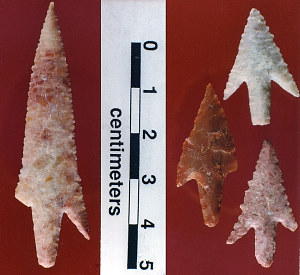Cielo Complex Cairn Burials
Two cairn burials documented in the Big Bend area represent a distinctive burial tradition dating to approximately A.D. 1400-1750 and are thought to be associated with the Cielo complex. The Las Haciendas and Rough Run cairn-burials were found less than 50 kilometers (30 miles) apart, one south of the Rio Grande and one north of the river not far from Lajitas, Texas. Both burials were accompanied by large numbers of Perdiz arrow points and a few other arrow points and artifacts as grave offerings. Clearly, these are not ordinary burials, they are elaborate ritual interments that required considerable effort, planning, and the disposal of personal “wealth.” The deceased, one a young man and the other an older man, must have been important individuals among the hunting and gathering peoples of the Cielo complex.
The Las Haciendas cairn burial was found near the small village of Las Haciendas (Paso de San Antonio) in northeastern Chihuahua, Mexico about 10 miles south of the Rio Grande’s Santa Elena Canyon. The cairn was placed on the backslope of a cuesta (a ridge with a steep face on one side and a gradual slope on the other), elevated some 15 meters (50 feet) above the surrounding creosote-covered desert basin. Sometime between A.D. 1500 and 1750, a young man was laid to rest on this promontory by other members of his group. They placed him in a shallow pit with an offering of 194 arrow points and covered him with soil, chunks of limestone, and two large boulders. The Las Haciendas assemblage constitutes the largest known sample of Perdiz arrow points recovered from a single cultural feature.
Las Haciendas was discovered and dug up by the residents of the nearby village in the summer of 1984. Afterward, they sold the arrow points they recovered to a collector from the United States. Enrique R. Madrid, regional archeological steward for the Texas Historical Commission (THC) notified then-Texas State Archeologist Robert Mallouf of the discovery, but was uncertain of the site’s exact location and the fate of its artifacts. Representatives of the THC tracked down the collection and arranged for its loan to Mallouf for scientific study. In the summer of 1986, Mallouf visited the site in order to record and photograph it. The cairn had been completely destroyed by the relic hunters, but by interviewing one of them and carefully scrutinizing the burial spot, Mallouf was able to reconstruct most of what had transpired.
The cairn contained the remains of a poorly preserved adolescent individual assumed to be a male given the large number of weapon tips left as offerings. Six teeth recovered from the cairn show variation suggesting that an adult individual may also be represented, however, the excavators were said to be certain that only a single body was present. The adolescent was laid on his back in a shallow pit with his legs extended and his head pointing south. The grave offerings included 194 arrow points, a drilled malachite pendant, and a kaolinite bead. All were tightly clustered just below the head, leading Mallouf to infer that these had been placed in one or several perishable containers (such as a leather pouch), rather than having been placed in the grave as hafted arrows.
The burial was covered with soil and chunks of limestone from the surrounding ground surface. Two large tabular rhyolite boulders, also from the immediate area, were then placed in tent-like fashion over the mound of limestone to protect the burial from scavengers and the elements. The location of the cairn at the edge of a distinctive landform and the position and directional orientation of the body interred within it fits the pattern of cairn burials throughout northern Mexico and the American Southwest, but its large number of arrow points is unusual.
Of the 194 arrow points, 180 are Perdiz points, 9 are basal-notched points similar to styles from adjacent regions that are variously known as Garza, Ciengas, and Soto points, 2 are Fresno points, 2 are untyped serrated side-notched points, and 1 is a Toyah point. All were made of raw materials found in the local area. Most (74%) were broken, but most breakage appears to have been related to use damage (most are just missing barb fragments), rather than to intentional ritual breakage. In fact, the high degree of variation and use damage strongly suggests that the points were selectively curated (saved) with the intention of refurbishing and recycling them.
The Perdiz points were the subject of a special study. The collection showed considerable morphological variety and were divided into 10 descriptive groups having subtle differences in blade, barb, and stem shape and size and other characteristics (finely serrated blade edges, for instance). These groupings were done to document the morphological variation between the Perdiz points, leading to the conclusion that they were made by at least several different individuals.
The malachite pendant is lightly ground and polished, and both sides have striations. The discoidal kaolinite bead has also been ground and polished. Both the pendant and the bead are made from local materials and are similar to other specimens found in the Big Bend region.
No radiocarbon assays were obtained from Las Haciendas. Based on the documented age ranges of Perdiz points and similar basal-notched points in the region, Mallouf estimated that the cairn burial at Las Haciendas likely dates to somewhere between A.D. 1500 and 1750.
The Rough Run burial cairn is similar in many respects to Las Haciendas, but much more is known about it because it was scientifically investigated. It was found in the late 1980s on an eroded bedrock bench above the Rough Run arroyo on the west side of Big Bend National Park (BBNP) in southwestern Brewster County. Over a three-year period archeologists William "Andy" Cloud, Thomas Alex of BBNP, and then-State Archeologist Robert Mallouf, with the assistance of other crew members, carefully documented and excavated the burial feature. Cloud analyzed and reported the Rough Run cairn burial in 2002.
The Rough Run cairn contained a secondary interment of an adult male over the age of 35. The deceased was partially dismembered with his arms, legs, and head removed from the torso, most of which was not found in the cairn. Nonetheless, the limbs were still intact and the partial body was placed in a deep pit in a flexed position with the head oriented toward the north-northwest.
The cairn was very tightly constructed with 300 tabular rhyolite stones that were taken from a nearby outcrop and transported to the burial site, despite the large quantity of other stones readily available in the immediate area of the cairn. Seven small chunks of charcoal and three pieces of debitage were recovered that were apparently scattered throughout the cairn during its construction. There was some indication that the cairn may have been partially disturbed or dug into at some point in the past, but, if so, the bones were not reached, a large number of arrow points were left behind, and most of the cairn remained as a tight cluster of piled rocks.
The grave offerings consisted of 64 whole and partial Perdiz arrow points and 1 Harrell arrow point. Unlike the Las Haciendas points, those with the Rough Run burial (with one exception) appeared to be scattered throughout the cairn as if they were tossed in as the cairn was being constructed. This could be an indication that some of the points were still hafted on arrow point foreshafts or complete arrows. Cloud inferred that at least seven of the Perdiz points were ritually broken or “killed” before being placed with the cairn. In these cases the pieces of each specimen could be fitted back together and the breakage looked intentional rather than accidental damage. The exceptional specimen was a finely made, oversized Perdiz point positioned above the individual’s head, pointing straight downward. This is thought to represent a “ceremonial” piece left as a special offering, rather than an ordinary arrow point tip such as the other points.
Like the Las Haciendas arrow points, the Rough Run arrow points were made from locally available raw materials and most had use breaks suggesting that they were curated specimens. They exhibit much less variation than the Las Haciendas points, however, suggesting that they were made by a single individual, likely the deceased. Two virtually identical radiocarbon assays obtained from the charcoal found in the cairn date the burial event to approximately A.D. 1450.
The locations of both cairns on elevated landforms and the predominance of Perdiz points in their assemblages suggest that they were constructed by people affiliated with the Cielo complex. Cielo complex peoples were hunter-gatherers who made Perdiz points and built distinctive circular or oval shaped wickiups (small brush structures) on elevated landforms throughout the Big Bend region. No stacked-stone structural remains typical of Cielo complex base camps were found at either Rough Run or Las Haciendas. The presence, however, of additional artifacts (Perdiz points, end scrapers, and a flake drill) usually associated with the Cielo complex in the site area around the Rough Run cairn supports the inferred Cielo complex linkage.
A good deal of energy was expended in the construction of both cairns. They were dug into extremely hard-packed, rocky soils. Rough Run was tightly constructed with a well-conceived plan and attention to detail, and the transport of 300 stones from the outcrop to the burial site would have been costly in terms of time and energy. Clearly, the individuals interred in these cairns must have been held in high esteem by the other members of their groups. The cairns’ locations on elevated landforms mirrors the location of Cielo complex base camps. Such promontories would have provided a vantage point from which to spot prey animals. This, along with burial offerings of arrow points, suggests that these individuals had a belief system closely tied to their subsistence patterns.
Contributed by Carly Whelan based on reports by Andy Cloud and Robert Mallouf cited below.
Sources
Cloud, William A.
2002 The Rough Run Burial: A Semi-Subterranean Cairn Burial from Brewster County, Texas. The Journal of Big Bend Studies 14:33-84.
Mallouf, Robert J.
1987 Las Haciendas: A Cairn-Burial Assemblage from Northeastern Chihuahua, Mexico. Office of the State Archeologist Report 35, Texas Historical Commission, Austin.
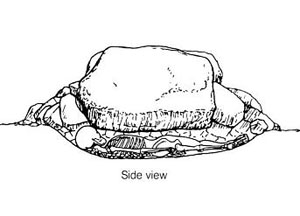
|

|
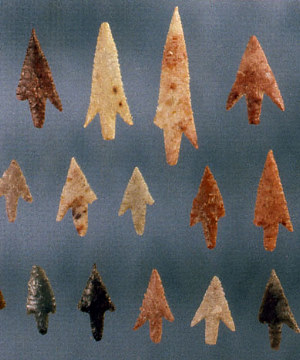
|

|
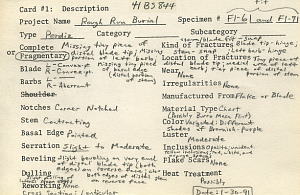
|
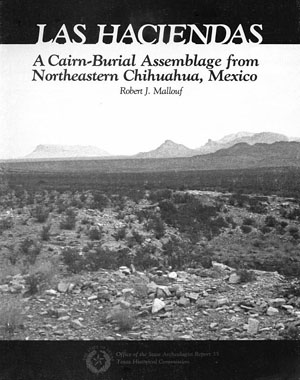
|

